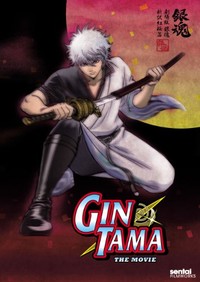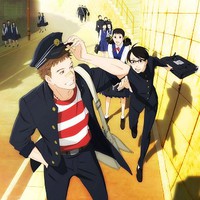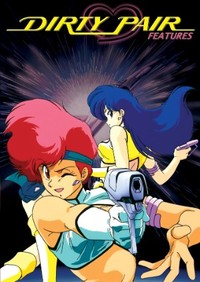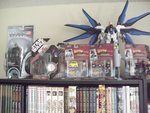Shelf Life
All the Gintama In the World
by Erin Finnegan,

Dirty Pair: Features DVD Collection
Rental Shelf
Gintama: The Movie BD
Perishable
None this week
Stream Worthy
Kids on the Slope ep. 1-9
I'll Have Another's withdrawal is a much bigger disappointment than Gintama: The Movie, which, unfortunately, was still a disappointment.
 I've reviewed Gintama, up to episode 26 or so, and then I skipped ahead to randomly watch episode 98, which was hilarious. (Too bad that season isn't on DVD, it seemed like a huge improvement over the first season.)
I've reviewed Gintama, up to episode 26 or so, and then I skipped ahead to randomly watch episode 98, which was hilarious. (Too bad that season isn't on DVD, it seemed like a huge improvement over the first season.) I love Gintama because it's funny, but this film decided to go in another direction. Rather than focusing on humor, it seems as if the makers delighted in finally having the budget to draw some very elaborate fight scenes.
The film starts off humorously enough, with not one, but two wipes over the Warner Brothers logo and an extended chat over a still background discussing the film's distribution deal with Warner Brothers. This sort of Warner Brothers meta-humor reminded me in a positively nostalgic way of The Animaniacs… and then the film takes a permanent turn for the serious as Kotaro is attacked by a serial killer and a very sad Elizabeth (my favorite character) enlists Yorozuya (“We do anything”) to help find Kotaro and solve the case.
Gintoki and friends wind up on the trail of a legendary (perhaps cursed, perhaps evil) sword called Benizakura in the subs, or “The Awesome Cherry Blossom” in the dub. In another Shonen Jump film, the swordsmith's daughter may have seemed like the extraneous new movie-only character no one cares about, but since Gintama is so episodic anyway, the random new character didn't bother me.
The film's climax is a large-scale airship battle with lots of samurai sword fighting action. In fact, the film seems to have several climaxes, to the point where I started wondering when it would be over. Puzzlingly, several tough-looking bad guys get introduced but never join the fight. Maybe they're characters from the larger series continuity that I haven't seen.
But, whatever; too much fighting, not enough laughing. If I wanted to see cool sword fights, I wouldn't have popped in Gintama. There are several scenes of disturbing machine tentacles popping Akira-style out of some dude's arm, and again, if I wanted to watch something dark and disturbing, I wouldn't have picked up Gintama.
I don't think any other part of Gintama has been dubbed into English, so it was cute to see the English cast. I liked Luci Christian as Kagura but hated Mark X. Laskowski as Shinpachi. His screechy frustrated shouting was so annoying that I kept switching back to the Japanese for Shinpachi-heavy scenes.
Besides having a dub, this is a bare bones release with no extras. The DVD menu screen doesn't move or feature any sound, which seems kind of cheap.
From going to Comiket, I know that Gintama has a large fujoshi fanbase who write endless comics about the shinsengumi characters, who I never got into in my dabbling with the show. I was thankful that the shinsengumi weren't in this movie much, because I can't seem to get them all straight. Many of the characters not appearing in the film get cameos in the closing bookend, which, to be fair, was legitimately funny.[TOP]
So Gintama: The Movie was disappointing, but not so bad as to be Perishable. The second stop on my train to disappointment town was Kids on the Slope.
 I was totally stoked to watch a Shinichiro Watanabe anime series about a high school jazz band. I mean, I'm not that into jazz, but I'm open minded about music. Make me love jazz, Watanabe (I thought)! When I read that the series was set in the 1960s, I was even more stoked. Bring on the historical drama!
I was totally stoked to watch a Shinichiro Watanabe anime series about a high school jazz band. I mean, I'm not that into jazz, but I'm open minded about music. Make me love jazz, Watanabe (I thought)! When I read that the series was set in the 1960s, I was even more stoked. Bring on the historical drama!Because I'm a fan of Watanabe, I'm quick to blame all the parts of this show I'm lukewarm about on the manga artist (Yuki Kodama). To begin with, there's Kaoru Nishimi, the rich nerdy kid who hasn't had many friends growing up (yawn) who plays piano. He becomes pals with Sentarō Kawabuchi, a 6-foot-tall delinquent jazz drummer from the wrong side of the tracks (cool). Kaoru falls for Ritsuko, a girl who's childhood friends with Sentarō (not another childhood friend!). Sentarō is oblivious that Ritsuko likes him (Arg!). Meanwhile, Kaoru respectfully (and painfully) keeps his distance from Ritsuko (again, yawn).
The love triangle is hands down the least interesting part of this show. Worse, it seems like a front hiding a secret fusjoshi agenda. Astute viewers will instantly slash Kaoru with Sentarō, forgetting about the dull, unimportant girl in the story. Kaoru fawning over Ritsuko takes a definitive backseat to Kaoru fawning over Sentarō.
If only Ritsuko had some musical talent (or passion), she might not seem like a ridiculous outsider in this show. She works in her family's record store and listens to the band practice, and for all of that I can't recall a scene of Ritsuko talking about music. In general, the characters spend very little time talking about bands or songs that they like. This might be frustrating for me on a personal level, since I spent so much of high school talking with boys about bands I liked – often bands from 1967!
Is it weird that I like that the characters are poor in a realistic way? Episode six is a beach episode, but it's couched in babysitting and a clam digging contest for the poor Kawabuchi family. Later, Ritsuko offers Kaoru a clam onigiri, which was a nice touch, as if families in the 1960s don't just go to the beach for leisure like in every other anime series.
Episode seven features a school festival concert analogous to other bringing-down-the-house best-concert-ever anime school festival scenes like in Haruhi Suzumiya or K-On!. The Slope equivalent seemed somewhat unrealistic to me… but I suppose it was more realistic than Haruhi Suzumiya, it's just odd that this is becoming a trope. Maybe Japanese school festivals really are like this. I've never been to one, after all.
Kids on the Slope is at its best when it touches on actual history. A concert in episode four turns awkward when a US serviceman in the audience is loud, drunk, and racist. Episode eight has a lot of flashbacks to Sentarō's older brother's time at college, which is more or less like a PTSD flashback to a war zone between riot cops and protestors. I wanted to see more historical stuff and less of Kaoru's dramatic moping.
That said, I'm excited to see the remaining episodes of the show, and I'm excitedly creating jazz playlists based on the soundtrack using Spotify.[TOP]
I enjoyed episode nine a great deal, so the week started to make a turnaround. I'm only slightly disappointed that there's no more original Dirty Pair to watch…
 So if I ever open a 1980s anime theme bar, I'll project Adieu Galaxy Express 999 and Dirty Pair: Project Eden on repeat against the walls (I'm open to your suggestions on this, too, dear reader). Both films have outstanding animation and some very trippy, colorful fantasy sequences that I think would make for great 80s atmosphere.
So if I ever open a 1980s anime theme bar, I'll project Adieu Galaxy Express 999 and Dirty Pair: Project Eden on repeat against the walls (I'm open to your suggestions on this, too, dear reader). Both films have outstanding animation and some very trippy, colorful fantasy sequences that I think would make for great 80s atmosphere.Several of my internet friends are of the opinion that if you want to introduce someone to Dirty Pair, you should just show them Project Eden. I respectfully disagree. Project Eden is certainly a fine film, but I think it doesn't quite capture Kei and Yuri as characters. Beginning viewers are better off watching the first episode of the TV series as a place to start. Afterward episodes and films can be watched out of order.
In Project Eden, the Dirty Pair are sent to investigate mysterious attacks on a mining camp and wind up facing off against a mad scientist. They lose their clothes early on (it's surprising the girls could wear even less clothing), but somehow it never seems exploitative. The rest of the film is all spectacular action sequences.
Dirty Pair: Flight 005 Conspiracy never quite reaches the heights of action and mayhem that Project Eden serves up, but it's still a very solid Dirty Pair story. Flight 005 is a bigger tale with more adventure than a given episode of the TV series, and as such it's a satisfying big summer action movie. Where Eden has more physical stunts and acrobatic action, Flight 005 has a richer mystery with more dialog, and we get a chance to see Yuri flex her deductive muscles.
Rounding out the collection, there's Dirty Pair: Affair on Nolandia. In terms of colors and costumes, Nolandia is almost so 80s it hurts. Kei and Yuri travel to planet Ookbar, where a little psychic girl is hiding in a mysterious jungle after causing some major destruction. The girl causes the Dirty Pair to have nightmares-within-nightmares (including tentacles). They plan to lure the girl out of hiding by having fun, and proceed to romp through the forest playing childlike games in an extended whimsical sequence that would be more fun if their laughter wasn't forced.
Nolandia is a strange movie, so strange that it even includes a freaking unicorn. It's made stranger by Kei and Yuri's more realistic character re-designs. It's an odd contrast that the girls should look more realistic in the least realistic Dirty Pair story.
This Right Stuf release includes both the Streamline dub and the ADV dub of all three films. I switched back and forth between the two and found that I liked the Streamline dub best; although there are more script changes, it's always done in the spirit of the script, and the actresses are just so much more passionate about the material. Lara Cody throws her heart into being Kei, whereas Pamela Lauer sounds a little bored. The ADV script differs from the subs too. You could watch these movies three times with three different translations and each has a different feel.
I know I'll end up re-watching these movies, and probably sooner rather than later. These are absolutely worth owning and sharing with friends, even if you don't own the Dirty Pair TV series. They're even worth re-buying if you only have the ADV dub. I'd like to take a closer look at Project Eden from a storyboardist's point of view, since the action scenes flow together so organically.
My favorite part about these movies is that once in a while there's a sloppy film splice that almost looks taped (most people will probably not notice this). Seeing the occasional splice reminded me that this was shot on film. The perfect shading and crazily detailed spaceships were all painstakingly hand painted without CG or even a single Ctrl+Z.[TOP]
That's all for this week. Speaking of unicorns, I picked up the Discotek release of The Fantastic Adventures of Unico for next week. I've never seen it before.

This week's shelves are from Forrest, who wrote the following:
"I like to read shelf life when it comes out and I see other otaku sending pictures of there shelves to you. So, I thought I would give my collection a shot. Over 250 titles, and it would take me somewhere over one hundred and ten days to watch it all. My interest started watching Adult Swim and Toonami and then in 2006, my collection started with Gundam Seed volume 1. I have a lot of hard to find titles like Record of Lodoss War and awesome movies like Summer Wars. Along the top are some of the action figures and models I have collected during trips to different cons and surfing the web."








Thanks for the photos!
Want to show off your shelves? Send your jpgs to [email protected]. Thanks!
discuss this in the forum (63 posts) |